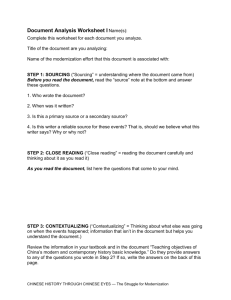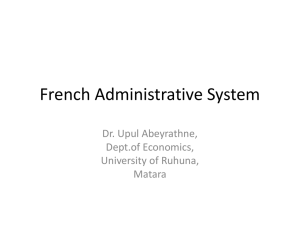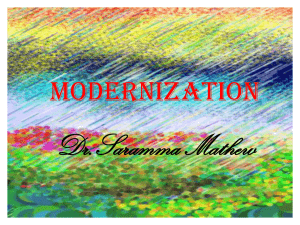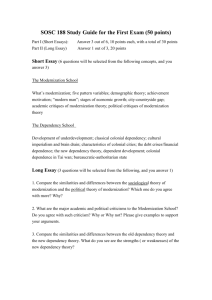China: The Struggle for Modernization
advertisement
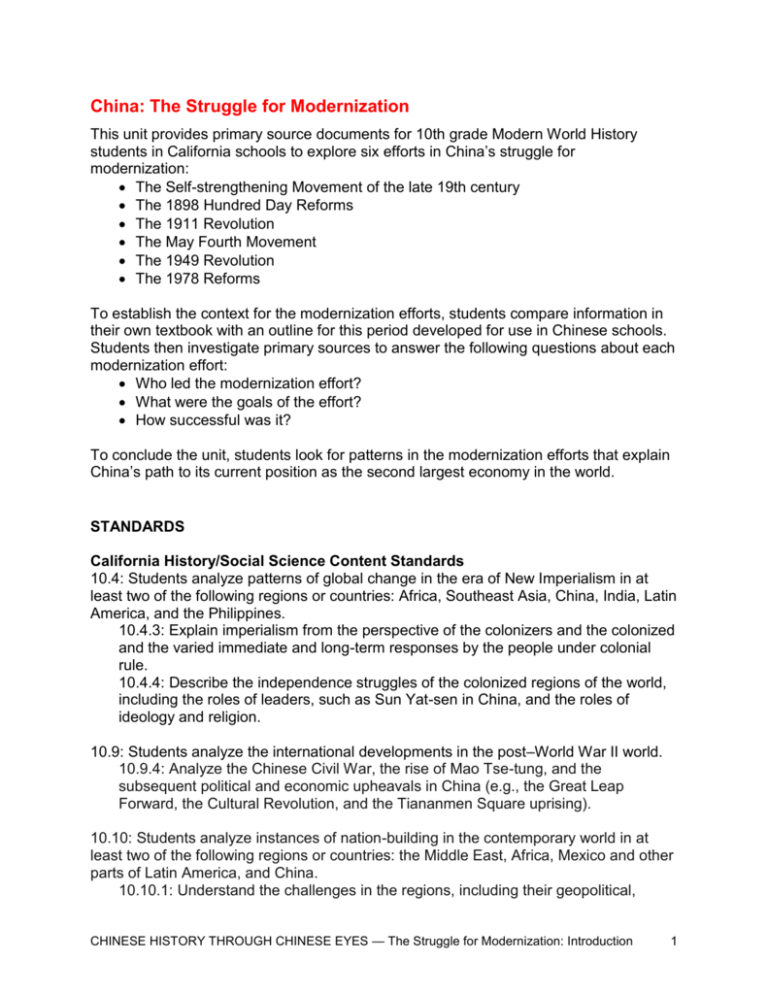
China: The Struggle for Modernization This unit provides primary source documents for 10th grade Modern World History students in California schools to explore six efforts in China’s struggle for modernization: The Self-strengthening Movement of the late 19th century The 1898 Hundred Day Reforms The 1911 Revolution The May Fourth Movement The 1949 Revolution The 1978 Reforms To establish the context for the modernization efforts, students compare information in their own textbook with an outline for this period developed for use in Chinese schools. Students then investigate primary sources to answer the following questions about each modernization effort: Who led the modernization effort? What were the goals of the effort? How successful was it? To conclude the unit, students look for patterns in the modernization efforts that explain China’s path to its current position as the second largest economy in the world. STANDARDS California History/Social Science Content Standards 10.4: Students analyze patterns of global change in the era of New Imperialism in at least two of the following regions or countries: Africa, Southeast Asia, China, India, Latin America, and the Philippines. 10.4.3: Explain imperialism from the perspective of the colonizers and the colonized and the varied immediate and long-term responses by the people under colonial rule. 10.4.4: Describe the independence struggles of the colonized regions of the world, including the roles of leaders, such as Sun Yat-sen in China, and the roles of ideology and religion. 10.9: Students analyze the international developments in the post–World War II world. 10.9.4: Analyze the Chinese Civil War, the rise of Mao Tse-tung, and the subsequent political and economic upheavals in China (e.g., the Great Leap Forward, the Cultural Revolution, and the Tiananmen Square uprising). 10.10: Students analyze instances of nation-building in the contemporary world in at least two of the following regions or countries: the Middle East, Africa, Mexico and other parts of Latin America, and China. 10.10.1: Understand the challenges in the regions, including their geopolitical, CHINESE HISTORY THROUGH CHINESE EYES — The Struggle for Modernization: Introduction 1 cultural, military, and economic significance and the international relationships in which they are involved. California Historical and Social Sciences Analytical Skills Chronological and Spatial Thinking: 2. Students analyze how change happens at different rates at different times; understand that some aspects can change while others remain the same; and understand that change is complicated and affects not only technology and politics but also values and beliefs. Historical Thinking Standards from the National Center for History in the Schools Standard 3: Historical Analysis and Interpretation Compare competing historical narratives. Standard 4: Historical Research Capabilities Interrogate historical data by uncovering the social, political, and economic context in which it was created; testing the data source for its credibility, authority, authenticity, internal consistency and completeness; and detecting and evaluating bias, distortion, and propaganda by omission, suppression, or invention of facts. Standard 5: Historical Issues Evaluate the implementation of a decision by analyzing the interests it served; estimating the position, power, and priority of each player involved; assessing the ethical dimensions of the decision; and evaluating its costs and benefits from a variety of perspectives. LEARNING GOALS OR OUTCOMES FOR THE UNIT 1. To understand China’s current economic development in the context of the 150-year struggle for modernization. 2. To understand the interplay of modernization efforts in the political, economic, and social spheres. 3. To practice reading and interpreting primary sources. ASSESSMENTS Formative assessments 1. During Contextualization Lessons A, B & C, check each student’s Contextualization Worksheets to assess understanding of the secondary sources. 2. During Modernization Lesson 1-6, check each student’s Document Analysis Worksheets to assess understanding of the primary sources. Summative assessment A writing exercise that requires students to synthesize information from all nine lessons. CHINESE HISTORY THROUGH CHINESE EYES — The Struggle for Modernization: Introduction 2 UNIT OUTLINE Introductory Slide Show Contextualization Lesson A: An overview of Chinese history from 1840 to 1900 – Comparing the textbook with a Chinese perspective Modernization Lesson 1: The Self-strengthening Movement Modernization Lesson 2: The 1898 Hundred Day Reforms Contextualization Lesson B: An overview of Chinese history from 1900 to 1931 – Comparing the textbook with a Chinese perspective Modernization Lesson 3: The Revolution of 1911 Modernization Lesson 4: The May Fourth Movement Contextualization Lesson C: An overview of Chinese history from 1931 to the present – Comparing the textbook with a Chinese perspective Modernization Lesson 5: The 1949 Revolution Modernization Lesson 6: The 1978 Reforms Conclusion: Looking for patterns in China’s path to modernization OVERVIEW OF STUDENT ACTIVITIES As the Unit Outline above suggests, following an introductory slide show, the lessons in this unit are constructed in parallel fashion so that once the procedures in the first lesson are mastered the following lessons should progress relatively quickly. Each pair of the Modernization Lessons is introduced with a Contextualization Lesson that asks students to compare an outline of that period of Chinese history that was developed for use in Chinese schools with the information in the students’ textbook. This activity (1) introduces students to the historical context for the modernization efforts they will study and (2) exposes them to competing historical narratives on the same topics. Each Modernization Lesson follows a similar format: 1. Students analyze primary source documents to determine (1) who led the modernization efforts and (2) what the goals of the effort were. CHINESE HISTORY THROUGH CHINESE EYES — The Struggle for Modernization: Introduction 3 2. Students read short secondary accounts that evaluate the successes and failures of the effort and then (3) formulate their own assessment of the effort. Both the Contextualization Lessons and the Modernization Lessons employ the Reading Like a Historian pedagogy developed by the Stanford History Education Group. This pedagogy teaches students to employ four historical thinking skills: sourcing, contextualizing, close reading, and corroborating. Further information is available at sheg.stanford.edu/?q=node/45. At the end of the unit, students look for patterns in the six modernization efforts they have studied to understand how, despite various mistakes and setbacks during the last 150 years, China has succeeded in finding a new place for itself in the global economy. These activities are described in more detail in the lesson plans that accompany each lesson. BACKGROUND NOTES FOR TEACHERS I have chosen modernization as the theme for this unit on Chinese history since 1840 for three reasons. First, assuming the unit is taught toward the end of California’s 10th grade Modern World History course, it builds on students’ knowledge of the Industrial Revolution, the French Revolution, European imperialism, and the Russian Revolution. By showing how these forces swept over China and shaped China’s struggle for modernization, the unit reinforces and deepens students’ understanding of these major events of Modern World History. Second, in choosing modernization as the theme of this unit I am following the lead of historian Immanuel C. Y. Hsü, who titled his 1,000-page survey of Chinese history since 1600 The Rise of Modern China. In this unit I have tried to present resources that allow Modern World History students the opportunity to understand in some detail the three “shaping forces” that Hsü sees as defining China’s struggle for modernization: The policies of various Chinese governments during the period, which include the Qing dynasty’s focus on self-preservation, the efforts following the 1911 Revolution to end the foreign concessions and re-establish central authority, CHINESE HISTORY THROUGH CHINESE EYES — The Struggle for Modernization: Introduction 4 and the efforts following the 1949 Revolution to achieve “socialist transformation, rapid industrialization, and big-power status.” The “subterranean currents” of resistance to government policies, which were often characterized by “nationalistic-racial protest against foreign elements in Chinese life,” including the Manchurian Qing rulers, European and American imperialists, and Japan. The responses of governments and others to the Industrial Revolution that had for the first time given Europeans economic and military advantages over China (Hsü, 2000, p. 7-10). This curriculum unit focuses especially on Hsü’s third point, on which he elaborates: Ironically, Western civilization, so creative and vital elsewhere, proved more destructive than constructive in its immediate confrontation with China. It precipitated the breakdown of the old order without substituting another, leaving the Chinese the difficult task of forging a new order out of the ruins of the old. … They were faced with the agonizing problem of deciding how much of Old China must be discarded and how much of the modern West must be accepted in order for China to exist and win a respectable place in the community of nations (Hsü, 2000, p. 9-10). The third reason I have chosen modernization as the theme for this unit concerns my goal of seeing Chinese history through Chinese eyes, as explained in the introduction to this curriculum project. Recently many Chinese historians of Chinese history have framed Chinese history since the 17th century or later in the context of modernization. (I do not include Hsü in this group, although he was born in China, received his early education in China, and includes many Chinese sources in his work. His academic training and his academic career, however, were in the United States.) Although my inability to read Chinese-language scholarship prevents me from presenting a comprehensive review of this academic literature, a few recently translated articles by Chinese historians offer insights into their thinking on the topic. CHINESE HISTORY THROUGH CHINESE EYES — The Struggle for Modernization: Introduction 5 Qian Chengdan, a historian at Beijing University, wrote in 2003 that “… it goes without saying that modernization is the dominant theme in contemporary China” (Qian, 2009, p. 17). He offers this definition of modernization: “Modernization” is a general concept with rich connotations, but we generally understand it in the following terms: modernization is a transition in human society and a transformation of civilization; modernization means replacing agricultural productivity with industrial productivity, which served as the foundation for social change on a large scale, resulting in the transformation from agricultural to industrial civilization; modernization is a transformational process whereby old civilizations are replaced by new ones; this is the way that society experiences change on a large scale (Qian, 2009, p. 18). A group of historians affiliated with the East China Normal University in Shanghai places the definition in a wider, global perspective: … our scholars came to some consensus on several topics: modernization is not a unique phenomenon of historical development occurring in just a few nations, but is a trend with universal meaning for the whole world; modernization means the complete change of all aspects of a society with industrialization as its core; modernization is a long process of social development that started in the fifteenth century, first developed in western European nations, and continues today (Xiang et al., 2009, p. 83). In an article published in China in 2003, Anhui Normal University history professor Wang Xudong and graduate student Li Junxiang concur that “modernization means industrialization” (Wang & Li, 2009, p. 47). Like other Chinese historians, they cite the Opium War of 1840-42 as the beginning of modernization in Chinese history both because it was Great Britain’s industrialized military that defeated China and because Chinese response to the defeat began the long process toward China’s own industrialization. They see “the pursuit of modernization as the main thread of modern Chinese history” (p. 49), and their reasoning in support of that analysis identifies a number of issues that inform the lessons in this unit. CHINESE HISTORY THROUGH CHINESE EYES — The Struggle for Modernization: Introduction 6 For one, Wang and Li argue that “modernization emphasizes the leading role of productive forces” (p. 49). In the Marxist tradition from which their work arises, this means that “the transformation in the economic sphere ignited revolutions at the political and cultural-intellectual levels” (p. 47), rather than the other way around. In keeping with this concept, I have emphasized economic factors in the lessons that are included in this unit, although I have also included political and cultural-intellectual (social) factors. The strongest example of the latter is the revolution in literature and language that the May Fourth Movement produced. For another, Wang and Li, like Hsü, see a connection between modernization and the struggle for national independence, “which is the essential precondition for implementing modernization” (p. 49). China was able to control the industrialization process to serve its own needs only when foreign aggressors were expelled – the Manchurians with the 1911 revolution and the Europeans, Americans, and Japanese in the wake of World War II and the 1949 revolution. Thus the student worksheets that accompany Contextualization Lessons A, B and C ask students to identify which events in the documents they are analyzing indicate Chinese resistance to feudalism (Manchu/Qing rule) and imperialism. In addition, a question in the concluding lesson asks students to reflect on the connections between the role of foreign intervention in Chinese affairs and the long road to the ultimate success of the industrialization as a consequence of the 1978 reforms. Wang and Li also emphasize a connection between modernization and democratic revolution in Chinese history. They define the 1911 revolution as “a bourgeois democratic revolution against imperialism and feudalism” (p. 52) and the 1949 revolution as a socialist revolution that established the authority of the proletariat. The primary source documents I have chosen for students to investigate the 1911 revolution, the 1949 revolution, and the 1978 reforms reflect this framework and vocabulary. The question of “reform vs. revolution” in the concluding lesson is also intended to make salient the connection between modernization and political revolution. In elaborating on these concepts, Wang and Li provide summaries of most of the modernization efforts featured in these lessons that might be helpful for teachers using the lessons. Their analysis of the Self-strengthening Movement (Lesson 1), in contrast CHINESE HISTORY THROUGH CHINESE EYES — The Struggle for Modernization: Introduction 7 to the views of some other Chinese historians, emphasizes the positive contribution it made to China’s industrial development (the economic dimension) rather than the goal of the movement’s leaders, who were Qing officials, to maintain Qing rule (the political dimension): It was under the supervision of those bureaucratic reformers that the machinedriven industrial enterprises, which represented the advanced productive forces, emerged in age-old China, and the new-style army and navy, which possessed a certain degree of defense capabilities, were created from scratch. Endeavors such as translation bureaus, military academies, and study-abroad programs were undertaken step by step, while the look of the ancient society was transformed by railroad, telegraph, and steamship navigation. All these embodied the historical trend of modern China in a more substantial way. At the same time, in examining the reforms, we find a discrepancy between the subjective intention of the Self-strengthening movement to buttress dynastic rule and its objective effect of undercutting it (p. 50-51). Wang and Li call the 1898 Hundred Day Reforms (Lesson 2) a “deepening of the Self-strengthening Movement” that added political reforms to an agenda that had until then been limited to economic reforms. Rather than focus on the failure of the 1898 Reforms, they emphasize what the effort contributed to the continuing struggle for modernization: A group of new-style intellectuals, troubled by domestic disorder and foreign invasions, gradually demanded reform in politics, opening up the government and breaking the yoke of feudal tradition. This ushered in modernization reform in the political sphere — the Hundred Days Reform of 1898. Despite its abortion, the Hundred Days Reform broke a historic path from which there was no return. The reformers’ agendas were eventually implemented during the New Policy Reform period [1898-1908], which brought the modernization drive to a new level. During this process, people’s ideas, moral ethics, customs, habits, and lifestyles all underwent change that led toward modernization (p. 50). CHINESE HISTORY THROUGH CHINESE EYES — The Struggle for Modernization: Introduction 8 Wang and Li’s assessment of the 1911 revolution is consistent with the assessments provided in Documents D and E in Lesson 3: “The 1911 Revolution toppled the Qing government that was incapable of continuing modernization and founded the advanced system of democratic republicanism” (p. 58). However, Chinese modernization was retarded after the 1911 Revolution, and there are several reasons for this: (1) There was no legitimate and generally accepted central government being established, and thus the political power that could have given impetus to modernization was too weak and unable to promote modernization on a national scale; (2) Domestic politics were out of control. The long-time civil war instigated by the warlords and the protracted confrontation between the Nationalist Party and the Communist Party undermined the political conditions needed for modernization; (3) The Japanese large-scale aggression toward China and its economic pillage trapped our country in the War of Resistance and made daily economic construction impossible, not to mention modernization (p. 59). In assessing the role of the 1949 revolution (Lesson 5) in the modernization of China, Wang and Li credit it with expelling foreign aggressors and establishing national independence. But their focus on modernization as first and foremost an economic process leads them to argue that it was not until the 1978 Reforms (Lesson 6) that industrialization finally succeeded. One failure of the earlier period was that “people attempted to build a highly centralized planning economy that did not suit the developmental level of the productive forces” and another was that “class struggle overshadowed economic construction,” a reference to the Great Proletarian Cultural Revolution (p. 51-52). (For further background on the May Fourth Movement, see the separate essay included with Modernization Lesson 4.) Beijing University historian Luo Rongqu provides a summary of China’s struggle for modernization in comparison with Japan that might be a useful reference for teachers implementing the lessons in this unit: CHINESE HISTORY THROUGH CHINESE EYES — The Struggle for Modernization: Introduction 9 … the modernization path of China … was a special case among East Asian countries, because it had the longest duration and the most setbacks. It is well known that China was a “Celestial Kingdom” that far surpassed Japan in population, natural resources, culture, and so on. Its modernization drive was initiated almost at the same time as Japan’s, but its momentum was much weaker. This was because the Qing dynasty encountered serious inner degeneration as well as semi-marginalization caused by Western encroachment. The top-down reforms pursued under the ancient regime included three main twists and turns: the Self-Strengthening movement [Lesson 1], the 1898 Reform movement [Lesson 2], and the Constitutional movement. The political crisis set off by China’s defeat at the hands of the newly rising Japan in the 1890s was particularly severe, as China was troubled by imperialist intrusion, national crisis, and the crumbling of China’s own dynastic rule. China did not spend a single day in peace and stability in the first half of the twentieth century, and this could not but deal a fatal blow to its modernization drive. The unique internal and external environments confronting Chinese modernization, including the developmental crisis that haunted all of world capitalism in the first half of the twentieth century, often caused changes in China’s choice of modernization model: from Japanesestyle constitutional monarchy to capitalistic republicanism, to Soviet-style socialism. Various models without consistency were a distinguishing feature of China’s long and tortuous road toward modernization. It is safe to say that China achieved a great, sustained transition toward becoming a modern industrialized power only after it carried out Deng Xiaoping’s new policy of socialism with Chinese characteristics and implemented substantial reforms in the economic system (Luo, 2009, p. 24-25). Sources Hsü, Immanuel C. Y. (2000). The Rise of Modern China (6th ed.). New York: Oxford University Press. CHINESE HISTORY THROUGH CHINESE EYES — The Struggle for Modernization: Introduction 10 Luo, Rongqu. (2009). New perspectives on historical development and the course of modernization in East Asia. Chinese Studies in History, 43(1), 17-27. Originally published in 1996. Retrieved from Academic Search Complete, May 20, 2011. Qian, Chengdan. (2009). Constructing a new disciplinary framework of modern world history around the theme of modernization. Chinese Studies in History, 42(3), 724. Originally published in 2003. Retrieved from Academic Search Complete, May 22, 2011. Wang, Xudong, & Li, Junxiang. (2009). Modernization and the study of modern Chinese history. Chinese Studies in History, 43(1), 46-60. Originally published in 2003. Retrieved from Academic Search Complete, May 20, 2011. Xiang, Xiang, Faqing Song, Jiafeng Wang, & Hongtu Li. (2009). World history studies in twentieth-century China. Chinese Studies in History, 42(3), 57-96. Originally published in 1999. Retrieved from Academic Search Complete, May 22, 2011. CHINESE HISTORY THROUGH CHINESE EYES — The Struggle for Modernization: Introduction 11
